Stereotactic Radiosurgery and SBRT in Türkiye
Stereotactic radiosurgery (SRS) is a non-invasive, high-precision radiotherapy treatment used to treat functional abnormalities and small tumors in the brain by directing many precisely focused beams of radiation (high doses of radiation) to the affected area with minimal impact on surrounding healthy tissue.
The (SBRT) is called stereotaxic radiotherapy for the body, in the event that stereotaxic radiosurgery (SRS) is applied to the body to treat various tumors .
Stereotactic radiosurgery (SRS) and stereotactic body radiotherapy (SBRT) are important alternatives to standard surgery, especially for patients who are unable to undergo conventional surgeries.
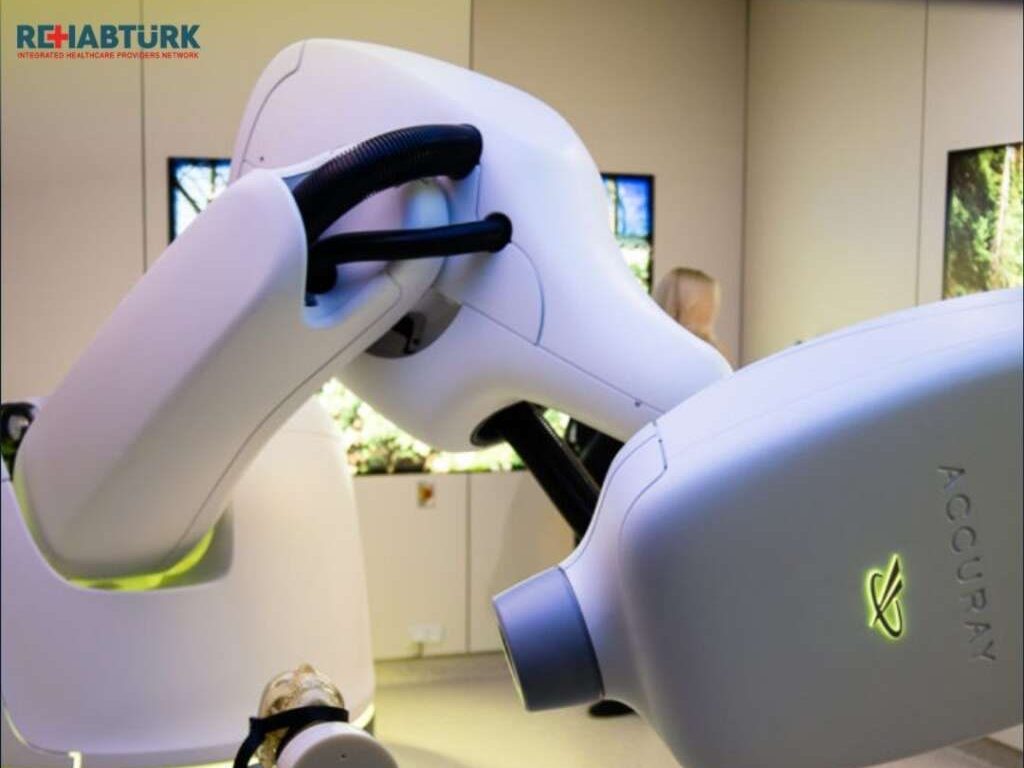
SRS and SBRT are based on several technologies, which are:
- 3D imaging and techniques that determine the target to be treated inside the body.
- Systems to immobilize the patient with precise immobilization during treatment.
- Highly focused gamma rays or X-rays are focused on the tumor.
- Image-guided radiotherapy (IGRT).
Note: Image-guided radiotherapy (IGRT) uses medical imaging to confirm the location of the tumor before and during radiation guidance.
This improves the accuracy of treatment and uses three-dimensional imaging such as computed tomography and magnetic resonance imaging.
In addition to positron emission tomography to determine the location of the tumor inside the body, its size and shape, and to plan the angles of the radial beams.
How many sessions does the treatment require?
SRS treatment consists of a single session, but doctors recommend (sometimes) multiple sessions if the tumor is more than 1 inch in diameter due to the higher dose ratio required to treat these tumors.
Therefore, splitting up the treatment session to improve safety and allow normal tissue to heal between treatments, splitting up the treatment into 2-5 sessions is referred to as fractionated stereotactic radiotherapy (SRT).
What are the uses of SRS and SBRT therapy?
Stereotactic radiosurgery (SRS) is used to treat many types of brain tumors, including:
- Both benign and malignant tumors.
- Primary and metastatic.
- Single or multiple tumor.
- Cancer cells remaining after surgery.
- Tumors within the skull, orbital , or at the base of the skull .
While SBRT is used in the treatment of small to medium sized malignant or benign tumors in the body including:
- the lungs
- liver
- abdomen
- vertebral column
- prostate
- head and neck
How does SRS treat tumors?
SRS works basically the same way as other forms of radiation therapy. But in fact, it does not remove the tumor, but rather damages the DNA of cancer cells, which makes them lose their ability to reproduce.
As a result, the benign tumors shrink over a period of 18 months to two years. But malignant tumors and metastases (metastatic tumors) may shrink more quickly.
And after the end of the treatment period, many tumors remain stable and inactive without any change, and this is considered a success. In some tumors, such as acoustic neuroma .
What devices are used during radiation therapy ?
There are three basic types of equipment used and each uses different tools and sources of radiation:
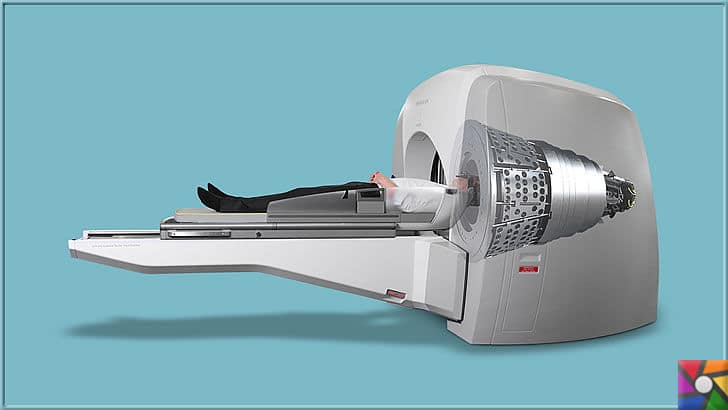
1. Gamma Knife :
The device uses 192 or 201 beams of highly focused gamma rays that target the target area and is suitable for treating small and medium-sized intracranial problems.
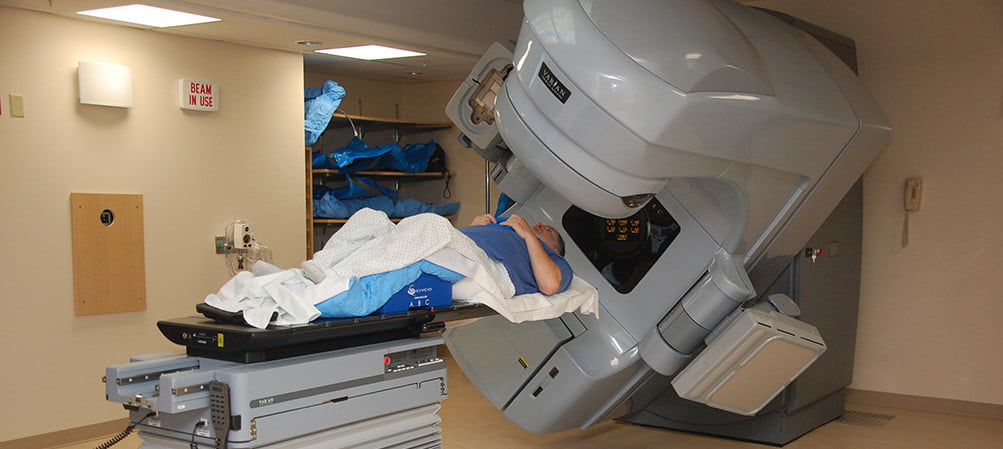
2. Linear Acceleration Systems ( LINAC )
Linear accelerator (LINAC) systems use high-energy X-rays to treat large tumors or other lesions outside the brain. Some of these systems are: LINAC CyberKnife, X-Knife, Novalis, and Peacock.
3. Proton beam therapy:
It is a type of partial beam radiotherapy that uses particles, such as neutrons or protons, the latter being the most widely used. Proton beam therapy is useful for treating small and/or irregularly shaped tumors or lesions.
The proton beam can be controlled to allow it to focus its energy on the tumor or lesion being treated without distraction, unlike other forms of radiation that lose part of their energy when they enter the body’s tissues.
It is also characterized by the lack of damage to the normal tissues surrounding the area under treatment due to the possibility of controlling the depth of the proton beam precisely.
4. CyberKnife
CyberKnife is considered one of the best devices in the treatment of cancer throughout the body in terms of safety and effectiveness!
The device uses a controlled high-energy beam of radiation to attack cancerous tumors. It is fired through a robotic arm that rotates so the ‘radiation’ can be targeted from (almost) any angle.
It also uses the latest medical imaging and motion tracking technologies to deliver radiation to the tumor with sub-millimeter accuracy, minimizing damage to surrounding tissues and cells.
The CyberKnife does not require the use of “toxic” chemicals, and the patient does not need to be placed under anesthesia. It also keeps the tissues surrounding the cancerous tumor intact.
Therefore, the device is superior to others in that the side effects are mild or non-existent. In addition to reducing the recovery time!!
note :
The Cyberknife is more non-invasive than the Gamma Knife. In addition to providing flexibility, accuracy, and a higher level of safety, CyberKnife is designed in a way that enables it to treat tumors all over the body!
What consists of the medical staff and who is responsible for operating and controlling the device?
The treatment team consists of a number of doctors and specialists, including a radiologist, radiologist, dosimeter, radiation therapist and nurses.
A radiation oncologist and a neurosurgeon lead the medical team, supervise the course of treatment and analyze data.
This is in addition to setting targets within the brain or body. A medical radiation physicist ensures that an accurate dose of radiation is delivered.
How is the operation performed using Gamma Knife ?
Gamma Knife radiosurgery includes four sections:
- Head frame mode.
- Imaging the tumor site.
- Dosage planning.
- radioactive conduction.
Stages of radiotherapy in Türkiye:
In the first stage, the nurse places a small needle in the hand or arm in order to give different drugs and contrast dye in case imaging is needed during the course of the operation. The neurosurgeon also uses local anesthesia to anesthetize two points in the forehead area and two points in the back of the head.
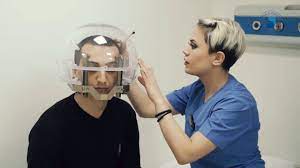
Then a frame made of lightweight aluminum is placed on the head and fixed using pins to prevent the head from moving inside the frame until the end of the treatment session. This frame is a guiding device that makes sure that the Gamma Knife packages target the area to be treated accurately.
Then the patient is taken to the imaging area where a magnetic resonance imaging (MRI) scan will be performed to show the exact location of the tumor.
A computerized tomography (CT) scan can also be performed instead of an MRI scan, and both can be performed. Angiography may be performed if the patient is undergoing treatment for an arteriovenous malformation .
Then, the treatment team develops a treatment plan using a special computer program to optimally deliver radiation to the tumor and reduce the dose to the surrounding normal tissues.
In the next stage, the treatment team goes to the control area outside the treatment room, and they can talk to them through a microphone, then the treatment actually begins after the Gamma Knife bed moves backwards, and the patient will not feel a thing.
Finally, the treatment ends. A ringing sound is issued when the treatment is completed, the bed is returned to its original position, and the head frame is removed
note :
The entire treatment may be performed without interruption or it may be divided into several smaller parts. The total treatment may last less than an hour or as long as four hours, and the patient can go home shortly thereafter.
How is the operation performed using Linear Acceleration Systems (LINAC) in Turkey?
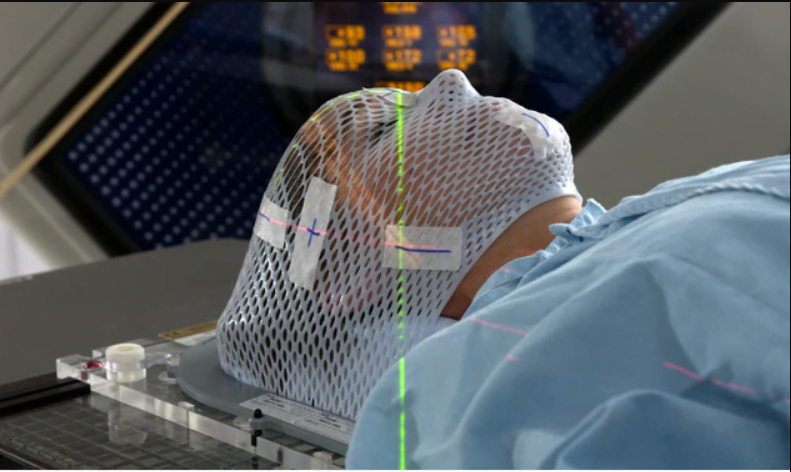
The procedure using linear accelerator systems is similar to that of the Gamma Knife and its four stages.
LINAC is more popular than Gamma Knife.
But the procedure differs from the previous one in that a part of the machine called the gantry rotates around the patient to deliver radiation beams from different angles.
It also differs from the previous one in that there is no need for a frame, and it is replaced by a more simple plastic head mask to prevent the head from moving during treatment.
This allows the use of fractionated stereotactic radiosurgery, or SBRT, which may also be an advantage for large tumors or those in particularly critical sites.
What are the stages of stereotactic body radiotherapy (SBRT) in Türkiye?
Stereotactic body radiotherapy (SBRT) usually consists of one to five treatments delivered over one to two weeks.
A private radiation oncologist works with a pulmonologist, gastroenterologist, or radiologist.
Treatment begins with placing one to four markers near the tumor after which the radiation oncologist determines how to align the body with linear accelerator beams (stabilizers are often used to align patients very precisely and make sure they stay still during treatment!).
In the next stage, a CT and X-ray examination is performed on the area to be treated, and information is obtained about how the tumor moves during breathing, if the tumor is in the lungs or liver .
The radiation oncologist works with a radiation dosimeter and medical physicist to plan and arrange the most appropriate beam and may incorporate imaging techniques, such as magnetic resonance imaging or PET/CT scanning.
Finally , the radiation therapist then directs the radiation, and sometimes an X-ray or CT scan is taken during treatment to monitor the position of the tumor. Treatment can take up to one hour or more.
What does the patient feel during and after radiotherapy?
Radiosurgery treatments are similar to X-ray imaging procedures in that you cannot see, feel or hear the radiation.
One exception, however, is that some patients receiving brain therapies may see flashes of light while the device is on even with their eyes closed.
There is also no pain or discomfort from the treatment, but if the patient feels pain for other reasons such as back pain or discomfort from the head frame or the fixation device, he must inform the doctor or specialist when removing the head frame.
However, there may be some minor bleeding from the pin sites which are later bandaged and radiosurgery and stereotactic radiotherapy patients can in most cases resume all their normal activities within a day or two.
What are the side effects:
The number and severity of side effects a patient experiences depends on the type of radiation, the amount of dose, and the part being treated. Side effects of radiation therapy include problems that occur as a result of the treatment itself, as well as from radiation damage to healthy cells in the treatment area, as well as early side effects, which include the following:
- Hair loss in the treatment area
- Mouth problems and difficulty swallowing
- Eating and digestion problems
- Diarrhea
- Vomiting and nausea
- Headache
- Soreness and swelling in the treatment area
- Changes in urine and bladder
Late side effects are rare and occur several months after treatment and are often permanent. They include:
- Changes in the brain or/and spinal cord or/and the lung or/and the kidneys or/and the colon and rectum
- infertility
- Lymphedema
- changes in the mouth
- Secondary cancer
- Bone fracture
Note: Radiotherapy can cause early side effects during or immediately after treatment, and they usually go away within a few weeks. Late side effects can occur months or years later.
Common side effects of radiation therapy include:
Tiredness or exhaustion and skin problems. The skin in the treatment area may become more sensitive, red, irritated, or swollen. Other skin changes include dryness, itching, peeling, and blistering.

Stereotaxic radiosurgery in Türkiye
The medical staff of surgical teams, doctors and consultants in REHABTÜRK can provide the best treatment options and free consultations – by striving to keep abreast of the latest medical technologies and methods.

